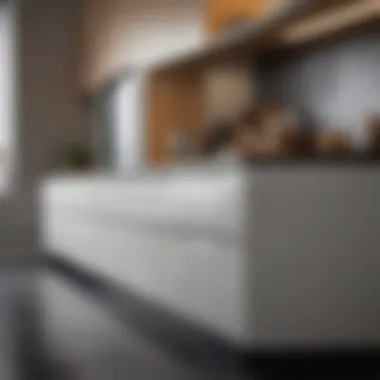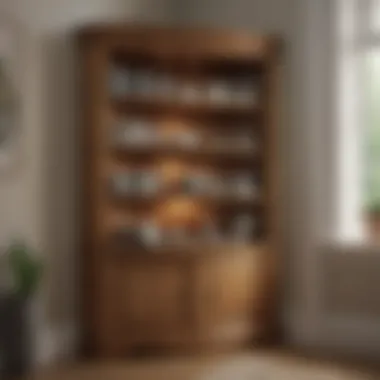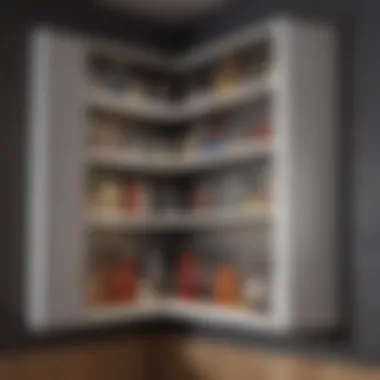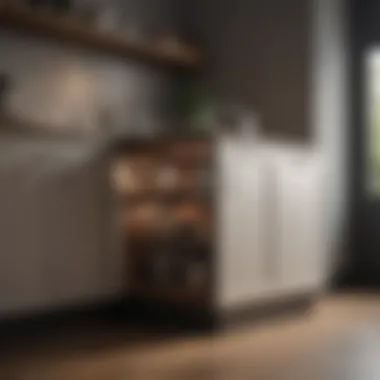Corner Kitchen Cabinet Design for Optimal Space


Intro
In the realm of kitchen design, corner cabinets often stand as both a challenge and an opportunity. While they possess the potential to augment storage space, they are also susceptible to inefficiencies that can hinder a kitchen's functionality. Emphasizing the design aspect can transform these cabinets into visually appealing focal points while maintaining their utility. Understanding the subtle intricacies of corner kitchen cabinet design is vital for anyone looking to optimize their cooking area. This article aims to delve into these nuances, offering insights into effective design strategies and practical implementation.
Design Inspiration
Current Interior Design Trends
As kitchens evolve, so too do the trends that influence their design. Contemporary kitchens increasingly favor minimalism, open spaces, and multi-functional elements. Corner cabinets, therefore, are adapting to encapsulate these shifts. For instance, sleek, handle-less designs allow for a crisp, uncluttered look, while integrating technology such as soft-close mechanisms enhances efficiency. In modern designs, materials like matte finishes and textured wood are gaining traction, bringing warmth and sophistication to kitchen interiors.
Color Palettes and Their Effects
Choosing the right color palette for corner kitchen cabinets can drastically affect the overall ambiance. Light colors, such as whites and pale blues, can create an illusion of space, making a small kitchen feel more expansive. On the other hand, deeper hues, like navy or forest green, exude elegance and invite a cozy atmosphere. Consider combining these colors with contrasting countertops or backsplash elements to create visual interest.
Incorporating pops of color through accessories can also make your corner kitchen cabinetry stand out without overwhelming the space. Ultimately, selecting a color palette that harmonizes with the overall design scheme of your kitchen is paramount.
"The color scheme you choose can influence not just aesthetics but also the emotional tone of your kitchen."
Practical Solutions and Storage Concepts
While aesthetic appeal is crucial, functionality cannot be overlooked. Corner cabinets offer unique opportunities for innovative storage solutions. Implementing pull-out shelves, lazy Susans, or even drawer systems can maximize space and improve access to items stored within these often-overlooked areas. Utilizing every inch of available space ensures that nothing goes to waste.
Consider the following storage concepts:
- Pull-out pantry shelves improve access while keeping items organized.
- Corner drawers can utilize space better than traditional cabinets.
- Rotating trays can also maximize accessibility in tight spots.
By thoughtfully designing the layout, homeowners can achieve a seamless blend of style and functionality. Each design element contributes to a kitchen environment that is both inviting and practical.
Understanding Corner Kitchen Cabinet Design
Understanding corner kitchen cabinet design is crucial in optimizing any kitchen layout. Corner cabinets often serve as hidden assets, providing storage solutions where traditional cabinets may fail. Recognizing their importance leads to better space utilization and enhances the overall aesthetics of the kitchen. By integrating corner cabinets effectively, homeowners can achieve a more functional space while maintaining an appealing look.
The Importance of Corner Cabinets
Corner cabinets significantly contribute to maximizing storage in a kitchen. They allow homeowners to utilize otherwise wasted space in corners. These cabinets can offer nearly double the storage compared to standard cabinets in similar sizes. This means more room for pots, pans, and various kitchen tools. Furthermore, corner cabinets can be custom designed to fit the unique geometry of each kitchen, allowing for flexibility in design and functionality.
Another important aspect is the visual interest they add to the kitchen. Well-designed corner cabinets can act as focal points, drawing the eye in a pleasing manner. When choosing styles and finishes, homeowners can create a coherent look that either complements or contrasts with the general theme of the kitchen. Therefore, both function and form are achieved when corner cabinets are properly accounted for in kitchen design.
Challenges Presented by Corner Spaces
Despite their benefits, corner cabinets come with specific challenges. One major issue is accessibility. Many traditional corner cabinets can be difficult to reach, making the items stored within hard to access. This can lead to frustration and a less efficient cooking process. Options like lazy susan cabinets or corner drawers can mitigate this problem by making better use of the space.
Another challenge is the design and fit of corner cabinets. Because of the angles involved, achieving a perfect fit can be complicated. This often leads to gaps that compromise both the aesthetic appeal and functionality of the cabinets. Selecting experienced designers or contractors can help ensure proper installation, thus avoiding common pitfalls.
In summary, understanding corner kitchen cabinet design requires recognizing both its significant advantages and potential challenges. With appropriate planning and consideration, these cabinets can dramatically enhance kitchen space while improving usability.
Types of Corner Kitchen Cabinets
Understanding the various types of corner kitchen cabinets is essential for maximizing space in your kitchen. Each type serves a specific function and offers unique benefits. This section will delve into the particulars of these cabinet designs, assessing their features, challenges, and considerations.
Lazy Susan Cabinets
Lazy Susan cabinets are a popular choice for corner spaces. They consist of rotating shelves that make access to items much simpler. With these cabinets, you can easily organize spices, canned goods, or small appliances.
The circular shape minimizes dead space in corners, allowing homeowners to utilize every inch efficiently. When selecting Lazy Susan cabinets, consider the height and depth. Make sure there is enough room for the rotating mechanism.
Additionally, these cabinets can be custom built to match your kitchen's aesthetic.
Corner Drawers
Corner drawers have gained fame for their clever design. They offer accessibility that standard cabinets often lack. Instead of a traditional door, they use a drawer style that can fully extend, providing access to the entire space. This feature allows for better organization of kitchen tools and utensils. It is worth noting that these come in various styles. You can choose shallow drawers for smaller items or deeper ones for pots and pans. When installing, ensure quality fixtures to handle the weight of the contents.
Diagonal Corner Cabinets
Diagonal corner cabinets present a unique option that adds an interesting visual element to a kitchen. Unlike standard corner designs, they extend out at an angle, presenting a more open look.
These cabinets can provide additional counter space which is beneficial for food preparation. However, their layout may require careful planning, as they could encroach on walkways if not positioned correctly. Also, customizing the interior layout will enhance utility and aesthetics.


Blind Corner Cabinets
Blind corner cabinets are typically less favored due to accessibility issues. They are designed to fit snugly into corners, but the rear space can be hard to reach. Despite this drawback, blind corner cabinets can be optimized with pull-out mechanisms or specialized organizers.
These additions improve utilization of the otherwise wasted space. Moreover, they can seamlessly integrate with the rest of your kitchen design, maintaining elegance without compromising space.
Each type of corner kitchen cabinet has distinct advantages and considerations. When planning your kitchen, reflect on how each can enhance functionality while ensuring that your design remains visually pleasing.
Design Styles for Corner Cabinets
In the realm of kitchen design, the choice of cabinet style can significantly influence both functionality and aesthetic appeal. Corner cabinets, often overlooked, provide a unique opportunity to blend form with function. Understanding various design styles allows homeowners to make informed choices that cater not only to personal taste but also to the overall kitchen ambiance. When thoughtfully integrated, corner cabinets can enhance the visual flow of a kitchen while maximizing storage space. In this section, we will explore different design styles that can be applied to corner cabinets, each with its own set of advantages, considerations, and merits.
Traditional Design
Traditional cabinet design exudes a timeless appeal that resonates with many homeowners. Characterized by intricate moldings, raised panel doors, and rich woods, this style creates a warm and inviting atmosphere. Corner cabinets in traditional design often feature curved fronts or glass doors, which adds elegance.
- Benefits:
- Offers a classic look that never goes out of style.
- Complements various decor themes, from rustic to refined.
For those aiming to create a cozy, inviting kitchen, traditional corner cabinets can be a perfect choice. However, it’s important to ensure that such cabinets align with the kitchen's overall theme to avoid a disjointed appearance.
Modern and Contemporary Style
On the other hand, modern and contemporary styles focus on minimalism and functionality. These designs often showcase clean lines, flat panel doors, and a mix of materials like metal and glass. Corner cabinets in this style are sleek and unobtrusive, often blending seamlessly with the kitchen's decor.
- Considerations:
- Emphasizes simplicity, which can make smaller kitchens feel more spacious.
- Offers versatility in color and finish, allowing customization.
Homeowners drawn to modern aesthetics will benefit from corner cabinets that provide streamlined storage solutions while maintaining a visually pleasing environment. The absence of ornate details in this style helps focus attention on the functional aspects of the kitchen.
Shaker Influence
Shaker-style cabinets are known for their functional design and simplicity. They feature a flat-panel door with a recessed center panel and come in various finishes. Shaker cabinets typically prioritize quality craftsmanship, making them both durable and stylish.
- Advantages:
- Offers a blend of traditional and modern sensibilities.
- Easy to maintain with a straightforward design.
Incorporating Shaker-style corner cabinets can provide a balanced appearance that works well with various decor styles. Their straightforward design makes them adaptable, enhancing both storage and style.
Farmhouse Aesthetics
Farmhouse-style kitchens have gained popularity for their charm and coziness. Corner cabinets designed in this way often feature distressed finishes, open shelving, and vintage hardware. They evoke a sense of warmth and nostalgia.
- Features:
- Focuses on natural materials and earthy colors.
- Encourages a relaxed, homey vibe.
Opting for farmhouse designs in corner cabinets can transform a kitchen into a welcoming space. The use of reclaimed wood and soft palettes can make a dramatic difference in the overall ambiance.
By understanding the various design styles available for corner cabinets, homeowners can better appreciate how each choice impacts their kitchen's functionality and aesthetic appeal.
Selecting Materials for Corner Cabinets
Choosing the right materials for corner cabinets is crucial for both aesthetics and functionality. The materials you select must balance durability, design versatility, and ease of maintenance.\n\nWhen thinking about your corner cabinetry, consider how the materials will interact with your overall kitchen design. This choice significantly impacts the longevity of your cabinets and can even influence how often you might need repairs or replacements. High-quality materials not only enhance the look of your kitchen but also provide necessary structural support, particularly in corner cabinets, which often face unique stress due to their position and usage.\n
Wood Options
Wood remains a popular choice for corner cabinetry due to its natural beauty and strength. Various types of wood offer different grains, colors, and hardness levels. For instance, oak provides durability and a noticeable grain, while maple offers a more subtle and clean finish. Hardwoods are typically favored as they resist warping better than softwoods.
Consider these aspects:
- Aesthetics: Different woods contribute unique character to your kitchen.
- Durability: Hardwoods like cherry and hickory withstand wear and tear effectively.
- Finishing Options: Wood can be stained, painted, or left in its natural state, providing design flexibility.\n Ultimately, wood options provide a warm, inviting feel to any kitchen design while ensuring the cabinet will last for many years with proper care.


Metal and Glass Accents
Integrating metal and glass elements into corner cabinets can elevate the visual appeal and modernity of the area. Metal frames can provide a sleek and contemporary look, while glass doors offer visibility to stored items, transforming functionality into a design statement.\n Considerations for using metal and glass include:
- Durability: Metal accents are typically resistant to damage, adding longevity.
- Visual Space: Glass can make a kitchen feel more open and lighter, countering the often cramped feel of corner designs.
- Maintenance: While glass requires regular cleaning to maintain clarity, metal can generally be wiped down easily with minimal effort.
It's essential to ensure that the metal and glass designs align with your broader kitchen aesthetic to maintain cohesiveness.\n
Laminate and Veneer Choices
Laminate and veneer materials offer practical and economical solutions for corner cabinetry. They provide an alternative to solid wood while still allowing for a diverse look. Laminate is known for its robust surface and ease of maintenance, making it ideal for busy kitchens.
Key points about laminate and veneer:
- Cost-effective: These options are usually more budget-friendly than solid wood.
- Design Possibilities: Both come in numerous colors and patterns, which can mimic the look of natural wood without the cost.
- Maintenance: Laminate is generally non-porous, making stains less likely and easier to remove.
Nevertheless, while these options are attractive and functional, consider their tendency to wear over time, particularly in high-traffic areas. Balance your choice with your kitchen's lifestyle needs and design theme.
"Choosing appropriate materials for corner cabinets not only influences visual aesthetics, but also the cabinet's performance in the kitchen."
In summary, selecting the right materials for your corner cabinets involves more than mere preference. It is about understanding the best options for your space while keeping design and usability in mind.
Storage Solutions for Corner Cabinets
Storage solutions for corner cabinets play an essential role in both functionality and aesthetics in kitchen design. A well-thought-out storage system can effectively utilize the often-neglected corners of a kitchen, transforming them into valuable areas that enhance overall efficiency. The unique geometry of corner cabinets can present challenges in organizing items. However, innovative storage solutions can maximize their potential, allowing homeowners to keep their kitchens clutter-free and organized.
Maximizing Vertical Space
Vertical space utilization is critical in corner cabinets due to their unique shapes. Often, the upper sections of these cabinets are underused. To maximize this space, consider installing adjustable shelves that can accommodate items of various heights. This flexibility allows homeowners to change the shelf height according to their needs. Also, incorporating tall cabinets that extend to the ceiling helps in utilizing every inch of available space.
Here are a few strategies to maximize vertical space:
- Tall Shelving Units: Install shelves that reach close to the ceiling.
- Stackable Bins: Use bins that can stack on each other to store small items.
- Pegboards: Attach pegboards inside cupboard doors for hanging utensils or pans.
Utilizing vertical space not only helps in organizing effectively but also makes accessibility easier by minimizing clutter below.
Incorporating Pull-Out Shelves
Pull-out shelves are an excellent addition for corner cabinets. They help in addressing the challenge of deep corners, making access to items stored inside easier. With a simple pull, shelves slide out, allowing homeowners to reach every item without having to bend or reach into the far back of the cabinet.
Considerations for pull-out shelves include:
- Weight Capacity: Ensure that the pull-out system can handle the weight of the items stored.
- Smooth Operation: Check if the sliding mechanism works smoothly.
- Customization: Look for systems that allow customization to fit specific items, such as pots or pantry goods.
This feature enhances usability and encourages organization, ensuring that nothing is tucked away and forgotten in the depths of the cabinet.
Utilizing Baskets and Organizers
Baskets and organizers can be extremely beneficial for corner cabinets. These tools provide defined spaces for different items, reducing chaos. They come in various shapes and sizes, allowing a tailored approach to organizing.
Some key benefits of using baskets and organizers include:
- Easy Access: Items can be pulled out easily when needed, minimizing the hassle of searching among clutter.
- Visual Appeal: Attractive baskets and organizers can enhance the aesthetics of the kitchen.
- Categorization: They help in categorizing items, such as snacks, spices, or utensils.
When selecting baskets and organizers, consider the material and design to ensure durability and visual harmony with the kitchen space.
Effective storage solutions not only improve functionality but also contribute to a harmonious kitchen design.
In summary, optimizing storage in corner cabinets involves thoughtful planning and innovative solutions. By maximizing vertical space, incorporating pull-out shelves, and utilizing baskets and organizers, homeowners can change how their kitchen functions and looks.
Installation Considerations for Corner Cabinets
Installing corner cabinets is not merely a matter of placing them in the right spot. The specifics of installation greatly influence the cabinet's functionality and aesthetic appeal. Proper installation ensures that the cabinets utilize space effectively and stand the test of time. Moreover, addressing installation aspects mitigates future issues, such as misalignment and structural weaknesses.


Measurement Accuracy
Accurate measurements are critical for corner cabinets. This is primarily because corner spaces can be notoriously tricky due to their unique shapes. When measuring, it is important to consider not only the dimensions of the cabinets but also the angles of the walls. Missing a fraction of an inch can make the difference between a snug fit and an awkward gap.
To achieve measurement precision, follow these steps:
- Use a Laser Level: This tool can assist in determining the exact height and placement of each cabinet.
- Record Multiple Measurements: Measure from different points to account for any irregularities in the wall or floor.
- Consider Adjacent Elements: Ensure that other kitchen components, like countertops or appliances, will work harmoniously with the cabinet placements.
Choosing the Right Fixtures
Selecting appropriate fixtures is another crucial aspect of corner cabinet installation. The right hinges, handles, and mounting brackets will contribute to both the functionality and durability of the cabinets.
Here are some guidelines when choosing fixtures:
- Quality Matters: Invest in high-grade fixtures that can withstand frequent use.
- Compatibility Check: Ensure that the chosen fixtures are compatible with the specific type of cabinet being installed.
- Aesthetic Alignment: The fixtures should complement the cabinet design. For instance, sleek, modern handles may not suit a traditional cabinet style.
Securing Cabinets Properly
Properly securing corner cabinets is vital for both safety and long-term performance. As corner cabinets are often used for storage of heavy items, there needs to be sufficient support to prevent them from tipping or collapsing.
Consider the following when securing cabinets:
- Use Appropriate Anchors: Depending on the wall material, different types of anchors and screws may be required.
- Leveling Cabinets: Ensure that all cabinets are level and plumb before securing them. This step can avoid future problems with doors not closing properly.
- Regular Checks: After installation, periodically check that the cabinets remain secure, especially if they are heavily loaded.
"Thorough preparation is the key to a successful installation of corner cabinets. An error in any phase can lead to inefficient use of space or structural weaknesses."
Maintenance and Care of Corner Cabinets
Maintaining and caring for corner kitchen cabinets is essential for both their longevity and aesthetic appeal. Corner cabinets, often used to optimize space, can be prone to unique challenges due to their location. Proper care ensures that they remain functional and visually pleasing over time. This section discusses practical cleaning techniques, addressing common damages, and ways to preserve finishes, allowing homeowners to sustain the beauty and utility of their corner cabinets.
Cleaning Techniques
Regular cleaning is crucial for maintaining the appearance of corner cabinets. Dust and grease can accumulate, particularly in corners which are less accessible. Here are some techniques you can consider:
- Use a Soft Cloth: Always start with a dry, soft cloth to wipe away dust. Microfiber cloths are ideal as they can trap dirt without scratching the surface.
- Special Cleaning Solutions: For sticky or greasy residues, a gentle cleaning solution might be required. A mix of warm water and gentle dish soap can work effectively. Avoid harsh chemicals that may damage the finish.
- Check for Hidden Spots: Pay special attention to hidden areas behind shelves or behind the cabinet doors. A soft, damp cloth can help access these difficult spots.
Cleaning not only improves the look of the cabinets but also prevents long-term damage that can stem from neglecting dirt and grime.
Repairing Damages
Corner cabinets are often susceptible to wear and tear. Understanding how to address damages can save homeowners from costly repairs. Here are some common repairs:
- Scratches and Scuff Marks: Light scratches can often be concealed using furniture markers or touch-up pens that match the cabinet’s finish. More severe scratches may require sanding and repainting the affected area.
- Loose Hinges and Hardware: Regularly check the hinges of the cabinet doors. Loose screws can be tightened with a screwdriver, and for much-needed support, consider applying a bit of wood glue.
- Panel Damage: If the wood is warped or damaged, replacing individual panels can rectify the issue. It may involve removing the door and carefully replacing the damaged piece.
Addressing damages quickly can prevent further deterioration, extending the cabinet's life significantly.
Preserving Finishes
The finish on corner cabinets is often what makes them visually appealing. Here are several methods to preserve them:
- Avoid Excess Moisture: Excess water can warp wood finishes. Always use a dry or slightly damp cloth for cleaning.
- Use Furniture Polish: Applying a quality furniture polish can not only enhance the shine but also protect the wood from environmental factors. Test in a small area first to avoid any negative reaction with the finish.
- Avoid Direct Sunlight: Sun exposure can fade finishes over time. Use window treatments to minimize direct sunlight hitting the cabinets.
By implementing these care techniques, homeowners can ensure their corner cabinets remain both functional and attractive. Regular maintenance plays a key role in maximizing the utility of the cabinet along with preserving its aesthetic attributes.
"Investing time in the maintenance of your corner cabinets ensures they will serve you well for years ahead."
End: Enhancing Kitchen Functionality
The design and installation of corner kitchen cabinets play a critical role in enhancing overall kitchen functionality. These spaces often pose unique challenges. However, when addressed thoughtfully, they can contribute significantly to a kitchen’s efficiency and aesthetic appeal.
Key Aspects of Corner Cabinet Functionality
- Optimal Use of Space: Corner cabinets facilitate the use of otherwise wasted space, often making them pivotal in smaller kitchens. Solutions such as lazy Susan cabinets or pull-out shelves allow for easy access and storage of kitchenware, keeping the area organized.
- Aesthetic Appeal: Corner cabinets can be designed to match the overall kitchen style, providing a cohesive look. Materials and finishes chosen can either blend in or serve as a focal point, thereby elevating the kitchen's aesthetic quality.
- Functional Design: Implementing various types of corner solutions, like corner drawers or blind cabinets, can enhance storage capacity. This functionality allows for the storage of cookware, appliances, and other essentials efficiently, accommodating the diverse needs of homeowners and users alike.
- Accessibility: Prioritizing access to stored items in corner cabinets is crucial. Proper design ensures that items placed within are easy to retrieve without disrupting the entire setup. This contributes to a smoother cooking and meal prep experience.
"With the right corner cabinet design, even the most awkward spaces can be turned into a model of efficiency."
This diverse range of elements ensures that kitchen designs remain functional and visually striking. Proper planning and execution can transform how spaces work. As homeowners rethink their kitchen layouts, prioritizing corner cabinets could lead to remarkable improvements not only in usability but also in the overall charm of their kitchens.
Thus, understanding the multifaceted nature of corner cabinet designs ensures that each kitchen becomes not just a functional working space but also a harmonious part of the home. With thoughtfulness and strategy, the potential of corner spaces can be fully realized.















